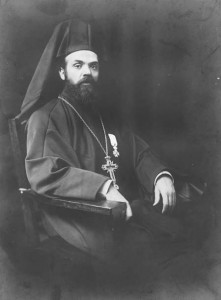St. Raphael Hawaweeny and Archdeacon (later Bishop) Emmanuel Abo-Hatab
It’s a common debate within American Orthodoxy: should our priests wear cassocks, or should they wear suits and collars like their Roman Catholic and Protestant counterparts?
One side rightly argues that cassocks are the traditional and virtually universal style of dress for Orthodox clergy. The other side just as correctly points out that even some American saints wore suits and collars. As with so many issues, both camps can cite historical precedent. This is from a New York Sun article shortly after St. Raphael’s consecration (5/22/1904):
The Bishop is only 42 years old. He is a handsome man, with piercing black eyes, a black beard and hair just tinged with gray, which is brushed back from his high forehead in long curling locks. He wears a costume which resembles the cassock of a Roman Catholic priest indoors, and a plain gold cross suspended around his neck by a golden chain. He has a democratic spirit, however, and has cut his long hair, which used to flow down over his shoulders to a more conventional length, and refuses to wear his pontificals in the street.
“I do not wish to attract attention by any peculiarities,” he says. “There is no reason why I should be so extreme.”
In the photo above, you can see St. Raphael and his archdeacon, the future Bishop Emmanuel Abo-Hatab, both wearing suits and holding their hats. Both men have closely-cropped beards and short hair.
That said, St. Raphael did not impose his own preferences on his clergy. For instance, check out the impressive beard on his priest, Archimandrite Meletios Karroum, printed in the Boston Globe (9/18/1904):
Archimandrite Meletios Karroum, 1904
Very generally, in the early 1900s, Russian clergy tended to be more “Westernized” in their appearance. Photos of St. John Kochurov from his time in America depict him with no facial hair at all. A lot of early Russian priests had only moustaches or goatees, and many wore suits. Take a look at this photo of St. Alexander Hotovitzky, from 1913:
St. Alexander Hotovitzky at the Conference on Faith and Order, 1913

Fr. Stephanos Macronis, San Francisco, 1911
Meanwhile, Greek clergy tended to be more traditional in their dress. As best I can tell, until the 1920s, Greek priests in America typically wore cassocks and sported full beards. In the ’20s, a general trend towards Americanization (pews, organs, etc) in Greek churches began, and it seems like collars and shaved faces became popular at about the same time.
More broadly, I would emphasize that diversity in clergy appearance has been pretty standard throughout American Orthodox history. Also, whatever their personal preferences, saints like Raphael did not impose their own views on their clergy. Flexibility, it seems, is generally to be preferred.
2 Replies to “Cassocks or Collars?”
Comments are closed.